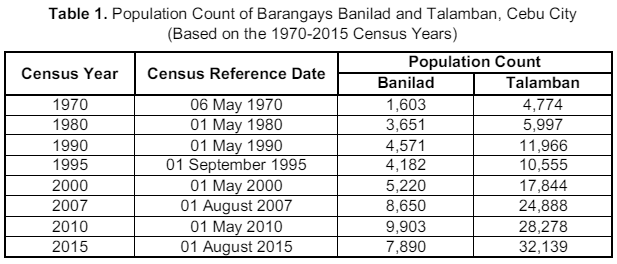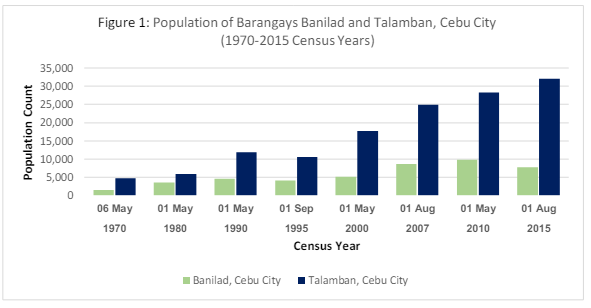In May 2020, the Philippine Statistics Authority (PSA) will conduct the 2020 Census of Population and Housing (CPH) in all barangays nationwide. With reference to the first census in 1903, the 2020 CPH will be the 15th census of population and 7th census of housing in the Philippines. Moreover, it will be the first census undertaking that will adopt the Computer-Assisted Personal Interview (CAPI) technique, which will involve the gathering of information through the use of an electronic questionnaire and geo-spatial information or map obtained in an electronic gadget (tablet).
In preparation for the conduct of the actual census in May 2020, a Pilot Census was conducted in May - June 2019 in selected areas nationwide. All households, housing units, Institutional Living Quarters, and barangays in the following areas were covered:
National Capital Region: Barangay Santo Cristo, Quezon City;
Luzon:
Municipality of Tublay, Benguet;
Municipality of Quirino, Isabela;
Visayas:
Barangay Banilad and Barangay Talamban, Cebu City;
Municipality of Biri, Northern Samar;
Mindanao:
Municipality of Dumingag, Zamboanga del Sur;
Municipality of Tagana-an, Surigao del Norte; and
Municipality of Simunul, Tawi-Tawi.
This Pilot Census serves as a dry run of all phases of census activities such as coordination; publicity and information, education, and communication (IEC) campaign, workload analysis and resource allocation; recruitment and hiring; training; mapping, listing, and enumeration; supervision and progress monitoring; and processing of accomplished questionnaires.
Generally, it aims to test the tools and procedures that may be recommended for use in the actual census and improve any aspect of them, if necessary. Specifically, the Pilot Census aims to: evaluate the census field operations procedures given the use of Computer-Assisted Personal Interview (CAPI) and Paper and Pencil Interview (PAPI) modes of data collection; test the efficiency of the data collection methods (CAPI/PAPI) and the mobile application used; assess the efficiency in the encoding of the accomplished PAPI questionnaire to the CAPI System; evaluate the Dashboard Monitoring System (DMS) at various levels; and evaluate the data processing and tabulation processes.
The Pilot Census is done approximately a year before the actual census to simulate the situations during the actual census and come up with recommendations on the best procedures and strategies that can be adopted in the actual census.
The authority and mandate of the PSA to conduct the 2020 Census of Population and Housing emanates primarily from Republic Act (RA) No. 10625 and Batas Pambansa Blg.72. As an overview:
RA No. 10625, also known as the Philippine Statistical Act of 2013, which was approved on 12 September 2013, states that “the PSA shall be primarily responsible for all national censuses and surveys, sectoral statistics, consolidation of administrative recording system, and compilation of national accounts”. Specifically, Section 6(b) of this Act mandates the PSA “to prepare and conduct periodic censuses on population, housing, agriculture, fisheries, business, industry, and other sectors of the country”;
Batas Pambansa Blg. 72, which passed into law on 11 June 1980, further accorded the PSA the authority to conduct population censuses every ten years beginning in 1980, without prejudice to the undertaking of special censuses on agriculture, industry, commerce, housing, and other sectors, as may be approved by the National Economic and Development Authority (NEDA).
All information provided by the respondents in all PSA statistical undertakings shall be held STRICTLY CONFIDENTIAL in accordance with RA No. 10625. Furthermore, pursuant to Republic Act No. 10173, also known as the Data Privacy Act of 2012, Section 4e states that this Act does not apply to information necessary in order to carry out the functions of public authority which includes the processing of personal data for the performance by the independent agencies of their constitutionally and statutorily mandated functions.
Three barangays in Highly Urbanized Cities (HUCs) nationwide plays a major role in this pilot testing. Cebu City takes two out of three barangays in HUCs being tested. As cited above, these are Barangays Banilad and Talamban. The population count over the past census years and the 2020 population projection for these two barangays were shown below.
Population Count

The total population of Banilad, Cebu City as of 01 August 2015 is 7,890, based on the 2015 Census of Population (POPCEN). The 2015 population is lower by 2,013 compared with the 2010 population of 9,903, and higher by 2,670 compared with the 5,220 population in 2000.
Meanwhile, the total population of Talamban, Cebu City as of 01 August 2015 is 32,139, based on the 2015 Census of Population (POPCEN). The 2015 population is higher by 3,861 compared with the 28,278 population in 2010, and by 14,285 population compared with the 2000 population of 17,844.

Population Projection

The 2020 estimated population of Banilad, Cebu City is 8,519, using the 2015-2020 Population Growth Rate (PGR) medium assumption of 0.01. This is higher by 629 compared with the 7,890 population in 2015.
For Barangay Talamban, Cebu City, the 2020 estimated population is 34,193, using the 2015-2020 Population Growth Rate (PGR) medium assumption of 0.03. The trend is increasing for this barangay since census year 2000.
These pilot areas will be visited again for the conduct of the actual census in May 2020.

